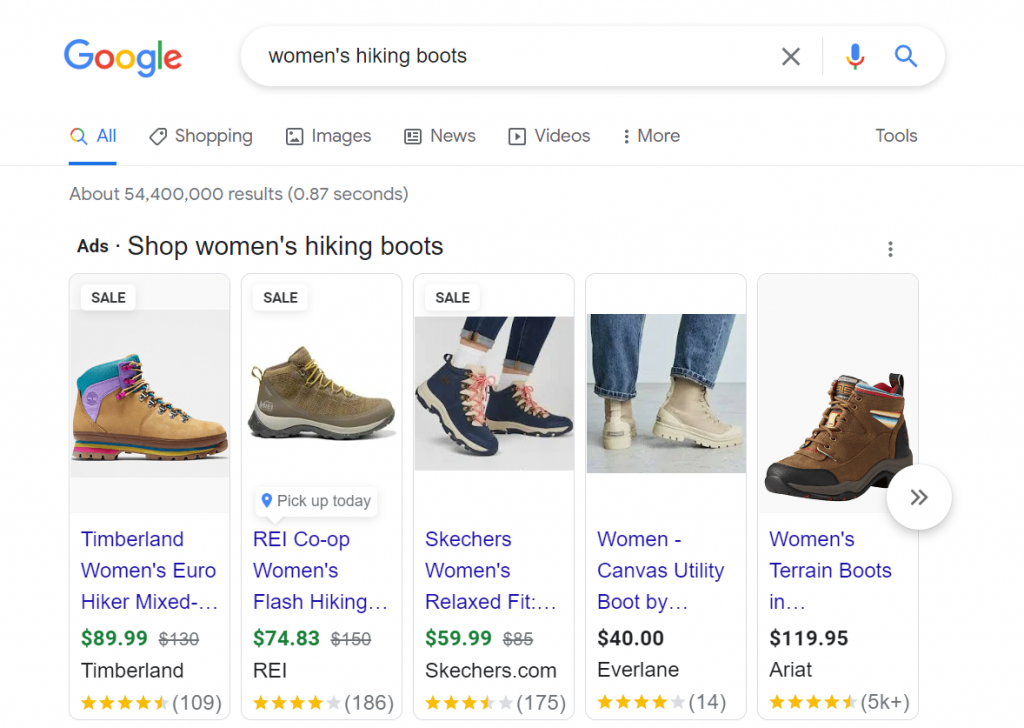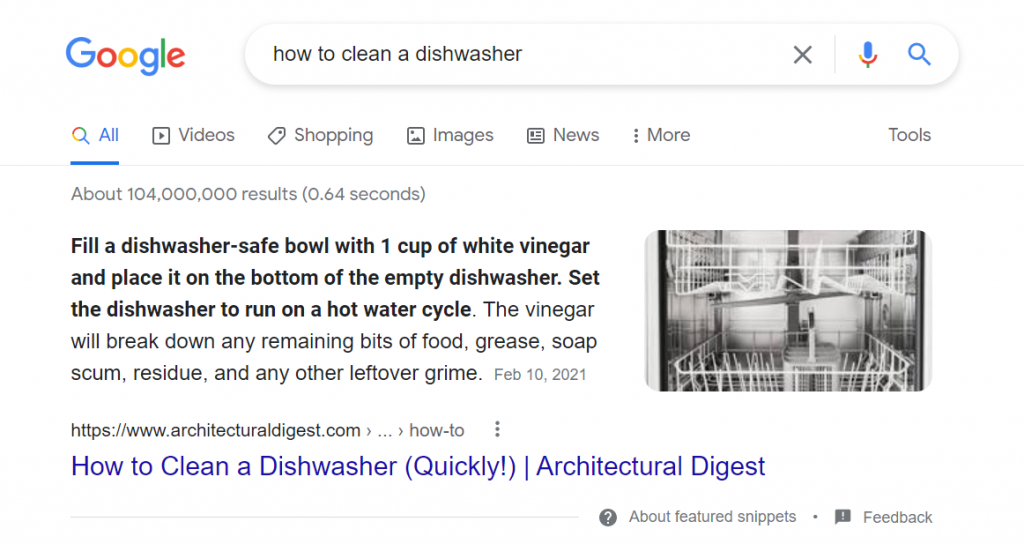- There’s no way to guarantee a page 1 ranking, but there are some practices that increase your chances of performing well.
- Some experts emphasize the importance of Google’s E-A-T principle. It’s also important to consider Google’s ranking factors.
- High-performing content typically is accurate and well-written, is optimized for keywords and search intent, contains useful links, relevant graphics, and descriptive meta tags, and includes a relevant CTA that considers the user’s needs.
Some say perfection is unattainable, but at RMG, we certainly won’t stop trying. We’ve been creating SEO blog content long enough to know that some types of content will usually outperform the rest.
While there’s no guarantee that any one piece of content will automatically rank on page 1, there are a handful of best practices that will set you up for success. They’re heavily informed by what Google claims to look for when ranking pages in the SERPs. So, let’s start there!
Note: There are many types of content that are important for an organization’s content marketing strategy. One type that consistently remains important for organic search success, though, is the blog. Virtually all of our clients publish blogs, and the organic traffic they bring does some heavy lifting for these brands’ SEO success. So, while the advice in this article applies to any crawlable content that your organization publishes, it is most applicable to blogs and other long-form written content.
Keep reading to learn what Google wants and how to deliver the goods.
Appeasing the algorithm
E-A-T
E-A-T – which stands for Expertise, Authoritativeness, and Trustworthiness – is such a common concept in organic search that Search Engine Journal has a six-chapter Google E-A-T Guide living permanently on their homepage.
To be clear, E-A-T is not a direct ranking factor (more on that later), and not everyone even agrees that E-A-T is important. However, we do know that Google prioritizes the user experience and thus favors content that does the same. If you look closely at each of the elements in E-A-T, it’s evident that following its principles would result in high quality content that meets users’ needs:
- Expertise – The content is created and published by a knowledgeable expert who can ensure accuracy.
- Authoritativeness – The content, content creator, and website has demonstrable authority in the field or subject being covered.
- Trustworthiness – The content, content creator, and website is a trusted source of information in the field or subject being covered.
Understanding SERPs
The search engine results pages, or SERPs, are the battleground of content marketing (or the playing field, if you prefer a less violent metaphor). Everybody wants to get on page 1, if not position 1. But the landscape has changed rapidly in recent years as Google adapts to varying user needs.
One thing content creators have had to adapt to is the development of specific SERP features that change the layout of SERPs. These features are intended to differentiate the way that search results are presented in order to serve specific user needs, such as buying a product, finding a quick answer, or looking at reviews for a local business. Adapting to these features is a matter of considering the search intent behind the keywords you’re targeting with the content.
Understanding ranking factors
Google has specified certain ranking factors, or as the name suggests, factors that determine what content is ranked highest on SERPs. There are varying opinions about which factors are most important, but a few routinely come up in expert discussions.
There is no exact science to achieving a page 1 result. However, adhering to ranking factors certainly doesn’t hurt your chances of organic SEO success. Almost every element of good content that we cover in this article is an important ranking factor for Google.
Anatomy of a perfect piece of content
1. Good writing
The most important aspect of content is, well, the actual content. You (or your writers) don’t need to use SAT vocabulary or have a PhD in the subject. In fact, the simpler, the better. However, remember the principles of E-A-T. The best content is made up of information that is accurate, well-researched, original, and communicated clearly and concisely. It should also be free from major grammatical and spelling errors.
Luckily, there are programs like Grammarly available to help you proofread your content and even check for plagiarism.
2. Keyword optimization
Keyword optimization is the only item on this list that isn’t an explicit ranking factor. However, we maintain that keyword optimization is important for adding purpose and structure to your content strategy. This is why we recommend that all good content marketing strategies start with keyword research.
During this stage of content creation, your organization discovers the short- and long-tail keywords it should target in organic search. Typically this involves considering your vertical, your target audience, your competitors’ keywords and rankings, and if possible, what you already rank well for.
The keyword research results then inform the content you produce and publish. Each piece of content should be produced with target keywords in mind – typically one to two primary keywords and possibly two to three supporting keywords. Use your primary keyword five to six times throughout the content, including in the page title, meta description, and H2s if possible. Use any supporting keywords two to three times throughout. Remember that keyword usage is no substitute for good writing.
Learn more about how to perform keyword research and the pros and cons of long-tail keywords.
3. Search intent optimization
Also called user intent, search intent refers to the goal of the user when performing a search. When you’re optimizing content for certain keywords, think about the search intent behind those keywords and optimize the content to help meet those user needs.
For example, is the user looking for information or to buy a product? There are four primary types of search intent: informational, commercial investigation, transactional, and navigational. Identifying which type corresponds to your target keywords helps you optimize content not just to user’s needs, but also to the Google SERPs. Google wants to serve the most relevant content to users with the best user experience possible. That’s why it’s developed distinct SERP features to serve different user intents.
For example, shopping results are designed for transactional searches. When you search “women’s hiking boots,” the SERPs will provide product results right at the top of the page.

For an informational search, on the other hand, such as “how to clean a dishwasher,” you will likely get a Featured Snippet (also known as Quick Answer) at the top of the page. Knowing the search intent of your target keywords helps you optimize for these SERP features.

4. Strategic linking
Linking is a fundamental part of good SEO content writing. This practice both improves the user experience by providing relevant additional information or resources, and helps Google make sense of the relationships between different pages on your site.
There are two types of links to include: internal links to your own pages (such as other content, contact forms, or product or service pages), and external links to reliable sources.
Internal linking tips: Keep a master list of your blog or other written content to make it easy to find relevant content for internal links. Use short, descriptive anchor text – bonus points if the anchor text contains target keywords from the content you’re linking to. Avoid congesting text with too many links close together. A good rule of thumb is to have at least 100 words between links.
External linking tips: Link to reliable sources wherever you reference information from their content. In general, avoid linking to the same source more than once. It’s best to link to pages with a domain authority that is similar to or higher than your own.
5. Images and graphics
Including relevant, high-quality images and graphics adds to the readability of your content. Text containing graphics is more engaging for readers since graphics break up large blocks of text and can clarify the concepts you’re writing about.
Use high-quality stock images from free sites like Unsplash to make content aesthetically pleasing. You can also use branded infographics or charts to present information in a visual way or screenshots to visually demonstrate what you’re discussing.
Remember to always include alt text for your images. Which brings us to…
6. Meta tags
Meta tags are a type of meta data that are crucial for search engines to be able to crawl and rank your content. These include but are not limited to clear and concise meta descriptions, headers throughout the content (H2s, H3s, etc.), and alt text for images.
Learn more about the role of structured data in SEO.
7. Call to Action (CTA)
Content should always have a purpose. That includes what action you hope the reader will take once they’ve finished reading. Do you want them to contact your team, fill out a form, or simply bookmark your blog to stay informed? If you’ve properly considered the search intent behind your target keywords, you should have a good idea of what kind of call to action (CTA) to include in your content.
Here are a couple examples: Now that you know the anatomy of a perfect piece of content, you might want to know more about content marketing best practices. You can find the answers to all your content questions in our blog!
Or maybe you’re wondering if you should work with some experts to get your content in top shape. In that case, reach out to the team at RMG – we’re happy to help!





